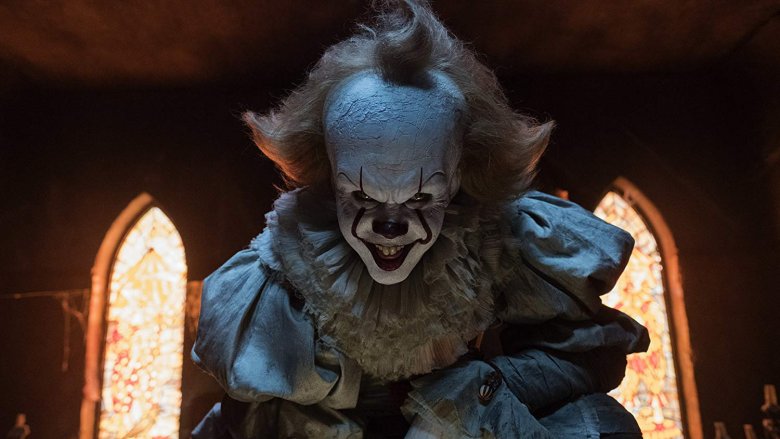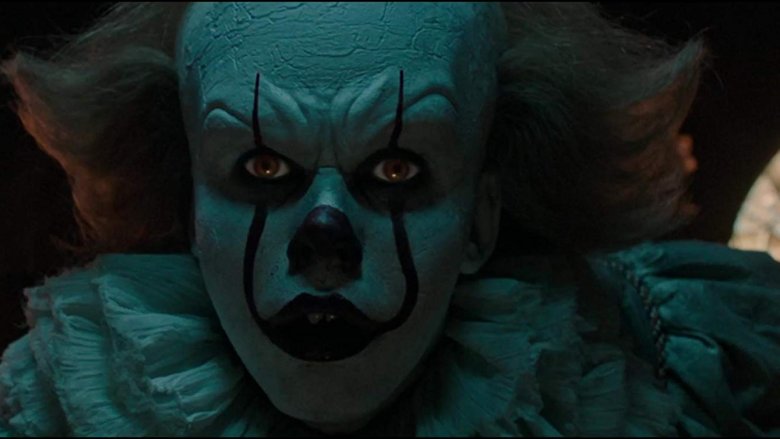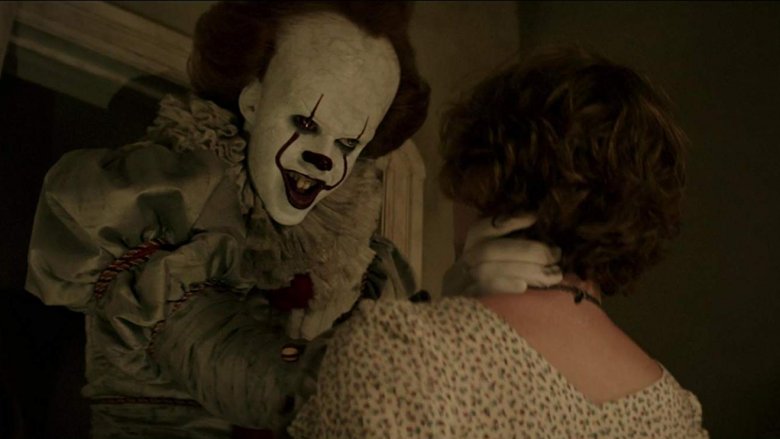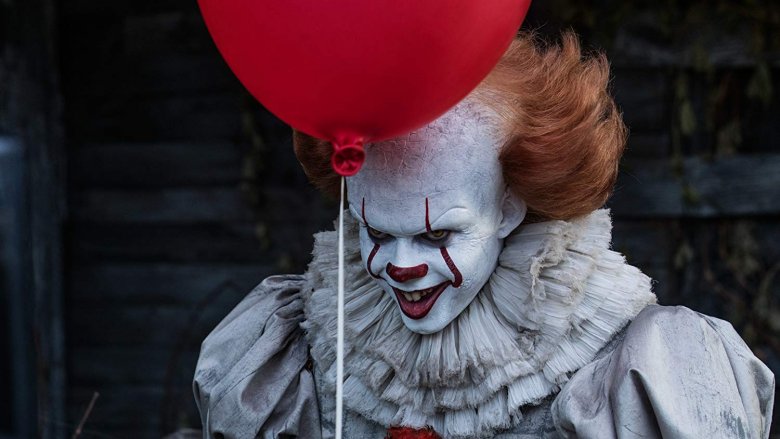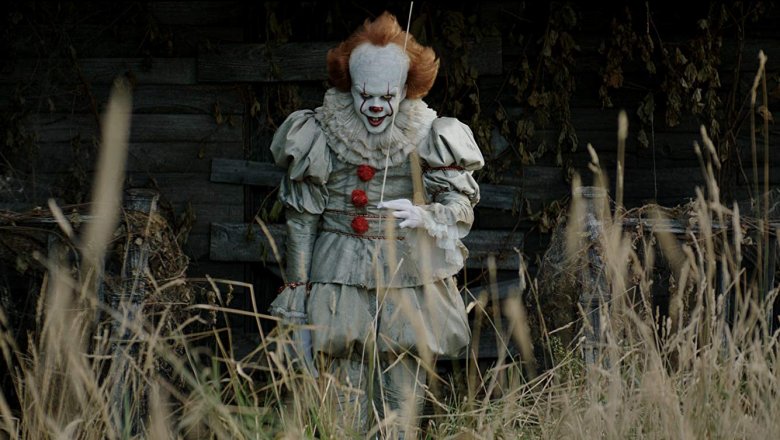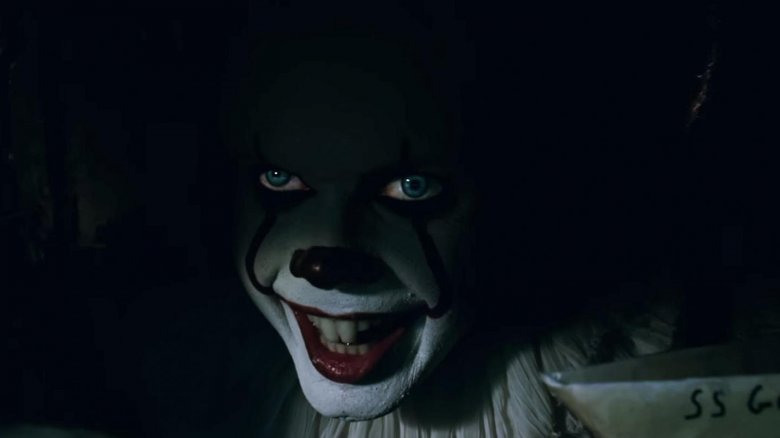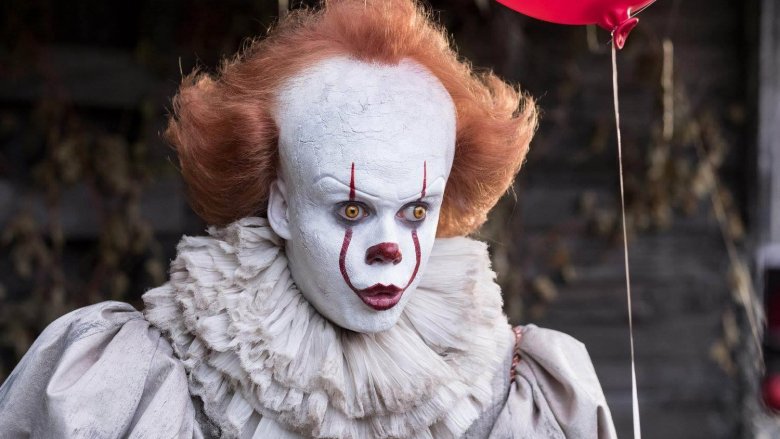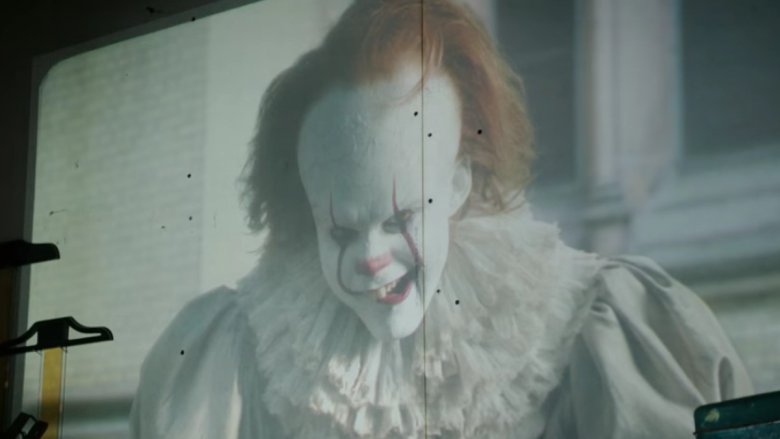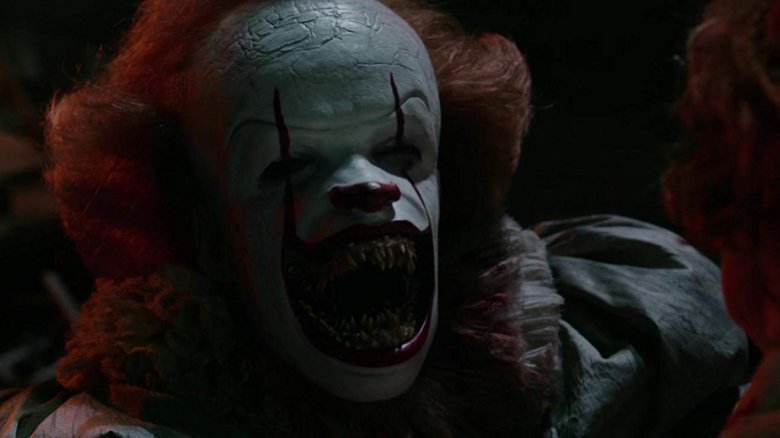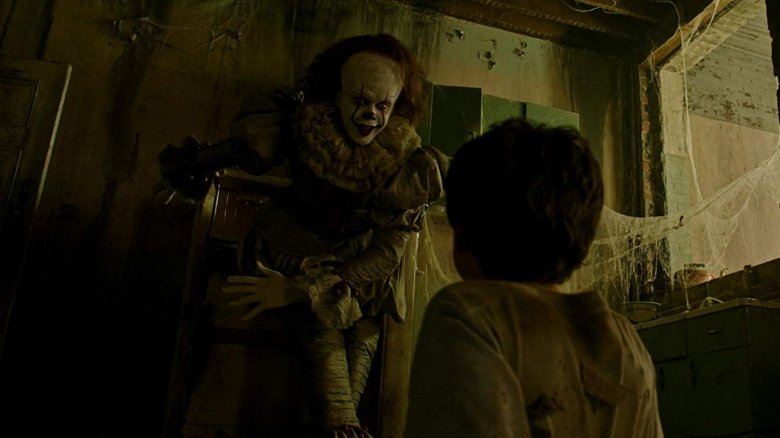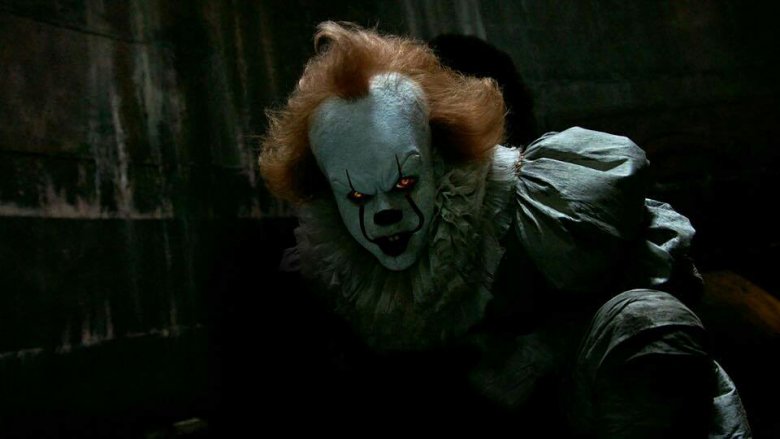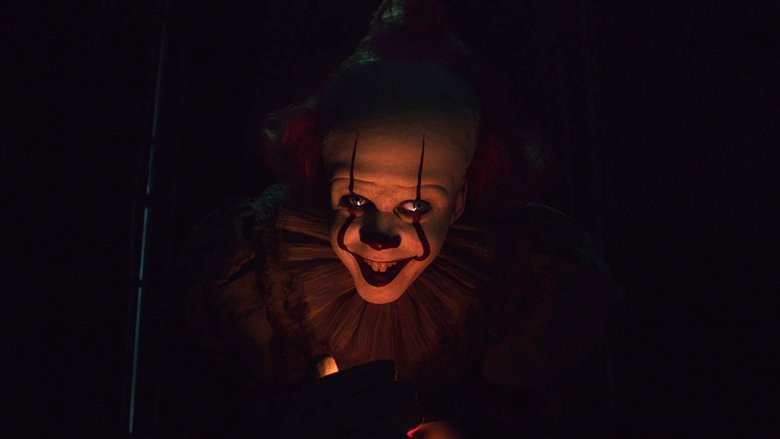How Bill Skarsgård Transformed Into Pennywise
In 2017, director Andy Muschietti brought us It, the first part of a terrifying new adaptation of Stephen King's novel about a group of kids (and later, adults) who find themselves facing off with a malevolent, ancient shapeshifter whose favorite form is that of a demonic clown named Pennywise. Pennywise was famously first brought to life by Tim Curry in the 1990 miniseries adaptation of It, and that performance is well-known for freaking out generations of children. If he was going to make his own mark, Muschietti needed a Pennywise for the ages.
For that he turned to actor Bill Skarsgård, then best known for dramas like Hemlock Grove and Victoria. Skarsgård, who came to his audition in clown makeup to prove his commitment, quickly dove into the character, studying King's novel and drawing from a wide variety of influences to create a clown that is equal parts childlike and ancient, vulnerable and ferocious.
From prosthetics to digital additions to Skarsgård's own facial manipulation, here's how he created Pennywise the Dancing Clown.
Back to the book
As he first began to bring the character to life in his head, Skarsgård realized he had to do more than just dream up a killer clown. Pennywise is, after all, just the most common physical form taken by an impossibly old cosmic evil that's able to shapeshift into virtually anything It wants in order to extract maximum fear from Its victims. To that end, the freaky cosmic entity had to come first in Skarsgård's head, and he felt he had to understand exactly why It turned into a clown so often. For that, he relied heavily on Stephen King's original novel.
"I wanted 'It' to really shine through Pennywise as opposed to just Pennywise being the clown. So a lot of what the entity is I wanted to be in the background of who Pennywise is at all times. There's a line in the original book where it goes something like 'the clown was its favorite form.' It really enjoyed being the clown," he told Collider. "Obviously, that opened ways of thinking. Why does he prefer being the clown? But also there is this sense of enjoyment... There were a lot of abstract ways to look at it."
He had to see before he could hear
Skarsgård began developing the character that would become Pennywise well before he actually started shooting any scenes. This meant that while he had the written word to rely on, he had very few visual cues to draw from as he first began to flesh out exactly what made It tick. This created certain challenges in designing the character, particularly in terms of his voice, which in the film ranges from childlike to nasal and wavering to outright monstrous. For Skarsgård, that voice and its many facets could not fully come into his head until he saw what Pennywise actually looked like.
"It was really when we did the full make-up test and see what the character would actually look like... it's a very abstract way of preparing for something when you have no idea what he will look like," he said. "I didn't know what the makeup would look like, I had no idea what the prosthetics would look like... My first test with the prosthetics and makeup was where I saw what the character would actually look like with me in it. That's something I needed to explore to [discover] what this thing would sound like."
It's all in the lips (and the lazy eye)
With makeup artists, digital effects artists, costumers, and Muschietti's own designs for the character, Skarsgård had a lot of help getting into the look of Pennywise. The character design has become so beloved since the film was released that makeup tutorials describing how to mimic it are legion on the internet, but there were certain aspects of the character that came directly from Skarsgård's own facial quirks.
Pennywise's demonic smile, for example, is created by Skarsgård drooping his lower lip down so that it almost comes to a point. That's not a prosthetic or digital effect, but simply something he's always been able to do. "I do this thing with my lip. It's a thing that I've been doing since I was a little kid, and I always wanted to bring this, like, lip thing to a character," he explained.
When Muschietti was designing the character, he had the idea that sometimes one of Pennywise's eyes would wander, and told Skarsgård that he would add the lazy eye in digitally in post-production. Skarsgård responded "I can do it," and revealed that he could trigger his own lazy eye.
"What are the chances that the actor that you cast can do that practically?" Muschietti said.
A precise costume
Because Pennywise is a clown, his costume was obviously always going to be a key part of the overall look, and for that Muschietti turned to costume designer Janie Bryant. Rather than take the more modern circus clown approach of the miniseries, Bryant went for something a little more timeless, with Victorian and even Elizabethan influence to give it a sense of history and even immortality. In shaping the costume, Bryant added peplum around the waist, a ruff at the neck, and other assorted blossoms of fabric to create a certain effect.
"I wanted it to have an organic, gourd or pumpkin kind of effect," Bryant said. "It helps exaggerate certain parts of the body. The costume is very nipped in the waist, and with the peplum and bloomers it has an expansive silhouette."
The exaggerated effect created by the costume gives the already tall Skarsgård the look of having impossibly long limbs, and the tightness around his torso suggests the body of an insect scuttling around the sewers of Derry. Bryant also emphasized a high waist and kept the pants short to add to the character's childlike qualities.
Childlike details
Pennywise is a character buried in makeup and an elaborate costume, which can make it difficult to figure out which parts of the character are the invention of a digital or makeup effects artist and which parts are Skarsgård himself. Muschietti and company kept as much of Skarsgård's own acting in the film as possible, often with subtle tweaks to boost certain qualities, particularly Pennywise's childlike demeanor that's expressed in his costume and also comes across in his voice.
To further accentuate this childlike quality, prosthetic pieces were added to Skarsgård's cheeks to make his face appear more round and add a certain fullness. The elongated false front teeth were also a part of this, giving the character an even more exaggerated smile. One of the biggest keys to the childlike aspect of Pennywise, though, came from Skarsgård himself. In his first scene, as he tries to befriend Georgie Denbrough, the bright blue eyes Pennywise displays are Skarsgård's own, natural eyes. He wore yellow contact lenses for the rest of the film.
A range of influences
In preparing for the role of Pennywise, Skarsgård made the decision to watch the iconic 1990 miniseries adaptation if IT, featuring Tim Curry's generation-terrifying performance as the dancing clown. He also made the decision not to specifically study Curry, because he knew his Pennywise needed to be different. To that end, Skarsgård brought together an intriguing and diverse array of influences. He studied footage of animals to help him get into the more predatory aspects of the character, and found himself particularly drawn to hyenas and bears as influences.
He also drew inspiration from another iconic clown of cinema, Heath Ledger's Joker in The Dark Knight, though Skarsgård acknowledged there were limits to that comparison. "Heath Ledger's Joker is rooted in the real; you can break down the psychology," he said. "But Pennywise is not a real person."
Both Skarsgård and Muschietti have emphasized the "childlike" quality of Pennywise, and to help bring that into the performance (particularly when Pennywise lunges at his victims), Skarsgård took inspiration from his little brother Ossian. "I don't know if you've seen kids run like this, but they move their arms way too fast, and it looks really, really funny," he said. "And I just loved the way my brother ran as a kid. It was just out of sync. So I incorporated that into the character, and you get this really explosive effect. It's really unsettling when it happens."
Hidden from the cast
A good movie monster does not exist in a vacuum. Very often the effectiveness of a horror villain is just as much about how much the other actors react to it as it is about the performance of the villain itself. Therefore, it was very important that all of Skarsgård's work not go to waste when he finally encountered the young actors who played the members of the Losers Club. Muschietti and his sister, producer Barbara Muschietti, decided it was best for Skarsgård to remain isolated from the rest of the cast for as long as possible. Skarsgård recalled being given his own tent on the set away from the other actors, and the young cast didn't even see what Pennywise looked like until they shot their first scene together.
"We wanted to keep him away from the kids as much as possible because we wanted their reaction to be real," Barbara Muschietti said.
The scene in which the kids first met Pennywise was the projector scene in the garage. Skarsgård also recalled that at one point he was worried he might actually frighten the kids in real life, but was put at ease during a scene in which Pennywise climbs on top of Eddie Kaspbrak (Jack Dylan Grazer) and drools all over him. As soon as Muschietti called "cut," Skarsgård asked if his young co-star was okay. Grazer replied, "That was awesome!"
Digital enhancements
Though Muschietti was determined to use practical effects as often as possible in the film (and most of the performance is Skarsgård), Pennywise is still a shapeshifting monster from another dimension, which meant that sometimes digital effects were going to be the way to go. Digital effects came in particularly handy when it came to designing Pennywise's expanding mouth with its rows of teeth. According to Rodeo FX visual effects supervisor Arnaud Brisebois, the effects team designed a digital "rig" that allowed them to animate Pennywise's terrifying mouth with as much detail as possible.
"The teeth rig was all hand-animated," Brisebois said. "We basically modeled the teeth all individually or as clusters that could be grown and oriented in any way."
The digital effects team was also called upon for the sequence in which Pennywise crawls out of the fridge (which was actually animated in reverse to give it an especially creepy look), and for the final showdown, in which the character is constantly changing shape. "Basically what they did was bring in all the stunt performers into a gym, and they learned the choreography and they motion-captured this," Brisebois said. "We built really quick CG assets for all the characters, including Pennywise, and we planned out all his transformations and the action."
The physicality of Pennywise
The movement of Pennywise is often just as important as his look, and Skarsgård put a lot of work into how the character's physicality would factor into the performance. He worked with a movement coach, studied animals, and even incorporated some of his younger brother's movements as a child into the performance. Near the end of the film, as the action picks up and Pennywise actually begins to physically fight the children, Skarsgård felt it was important to do as much of the stunt work as he could.
"There's so much about some of the fight sequences in the movie where Pennywise's physicality must be Pennywise's physicality, and I wanted to bring my movement and physicality in as much as I could," he said. "It was exhausting." Skarsgård recalled some scenes being so intense that he would collapse on the ground to catch his breath at the end of takes, while the younger actors around him would ask if he was okay.
Haunted by nightmares
After It hit theaters in September 2017, it became a phenomenon, one of the most successful R-rated films of all time. That meant people all around the world were taking in Skarsgård's performance as Pennywise, and many of them were likely legitimately freaked out by it. If you were one of the people who had nightmares about Pennywise the Dancing Clown after you saw the film, you weren't alone. It turns out Skarsgård himself was also plagued by bad dreams about his own character.
"It was in the shape of either me dealing with him, sort of Pennywise as a separate entity of me, and then also me as Pennywise in circumstances that I didn't appreciate... Like, I'm Pennywise and I'm really upset that I'm out in public and people are looking at me," he revealed. Skarsgård interpreted his bedtime encounters with his own creation as part of the process of "letting go of the monster."
'Instantly' returning to the character
This fall, Skarsgård will return as Pennywise in It: Chapter Two, a sequel adapting the other half of King's massive novel that will feature the adult Losers Club returning to Derry to battle the entity they hoped they'd destroyed as children one more time. Muschietti is returning as director, and the adult cast now includes James McAvoy, Jessica Chastain, Bill Hader, and more. Last summer, the cast began assembling to shoot Chapter Two, and that's when Skarsgård discovered that "re-adapting" himself for a sequel was almost frighteningly easy.
"I was surprised how much of the character was just there already," he recalled. "I instantly could access him again, like it was yesterday that we wrapped the first one. It was just all there. So the work and preparation and figuring out the character is almost intuitive, which is pretty cool. It's a very strange thing, but I'm trying to enjoy the ride, as much as I can."
